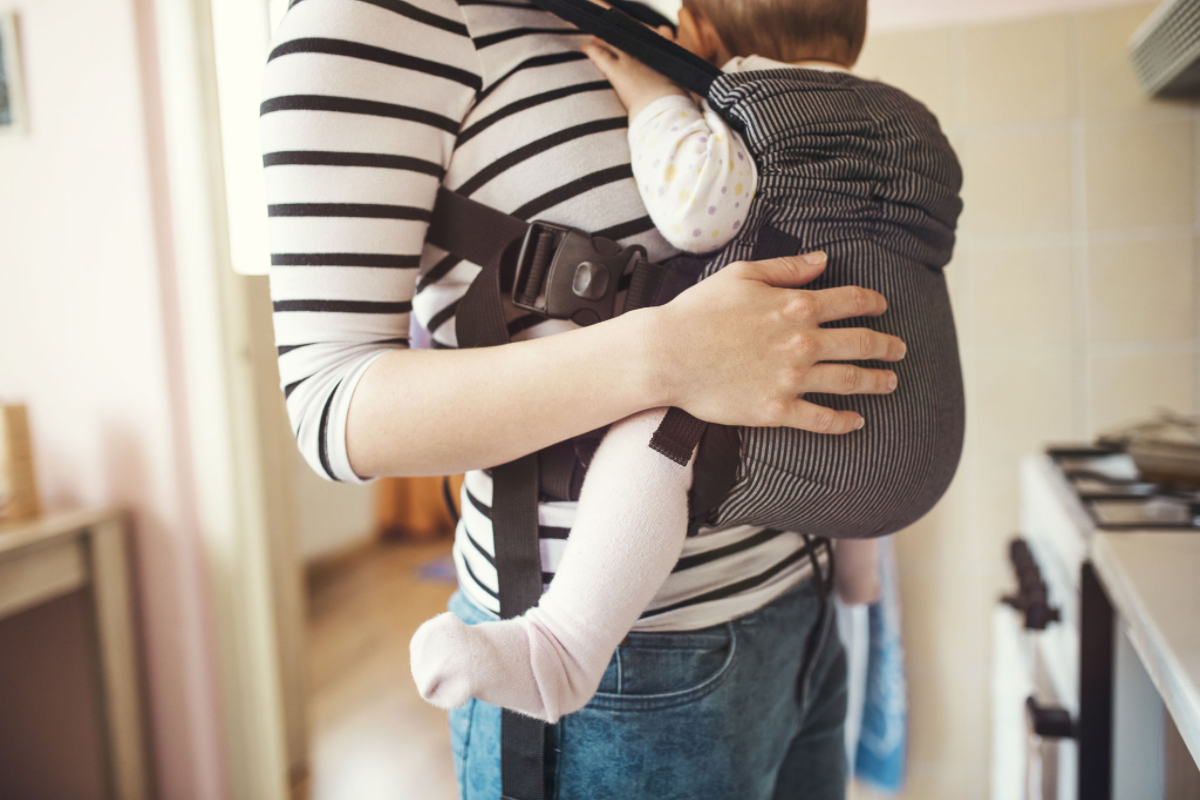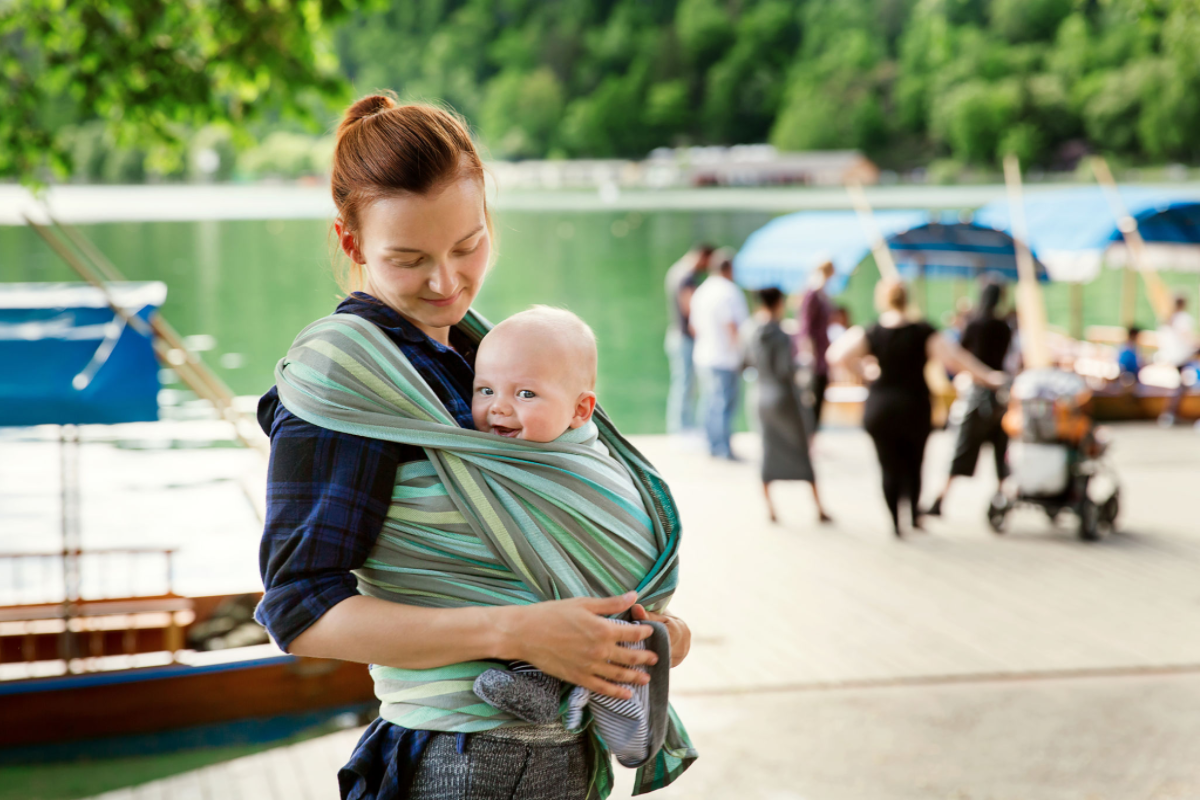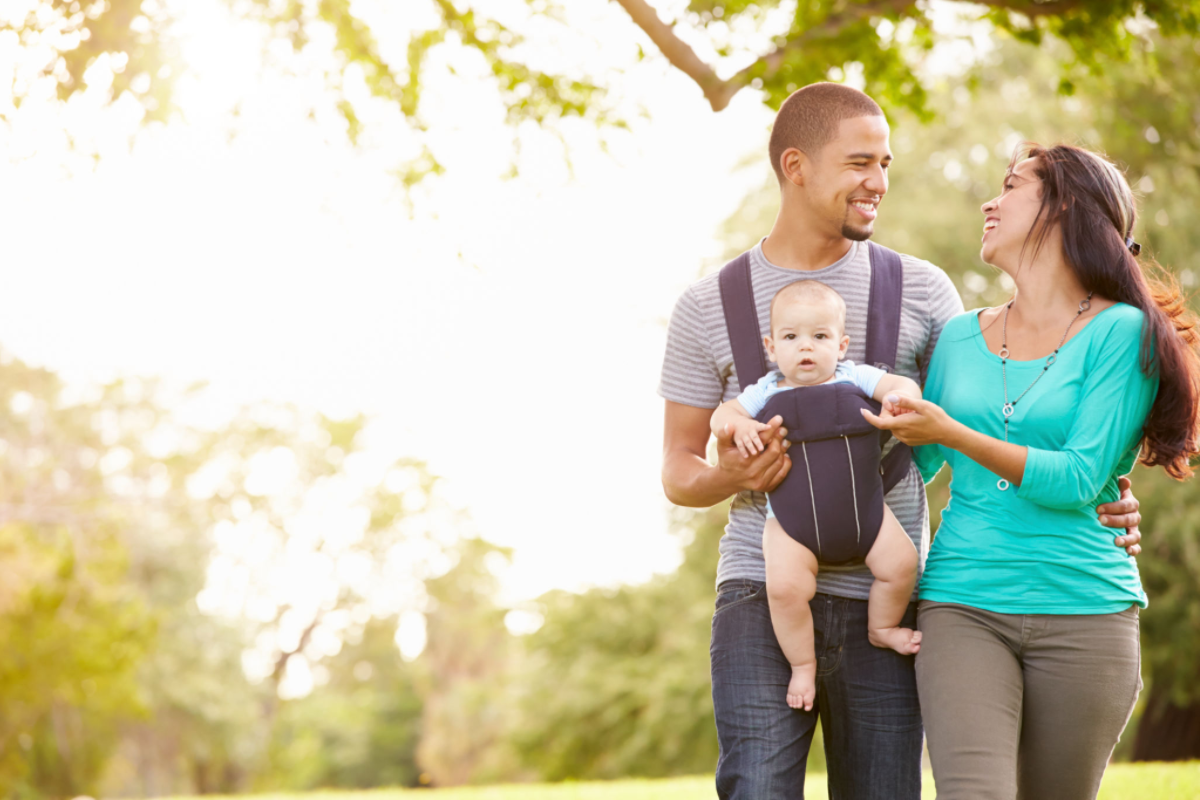Welcoming a new addition to the family is an extraordinary journey, filled with joy, wonder, and countless precious moments. For parents, especially those with infants and young children, the concept of babywearing can be a game-changer. Imagine holding your little one close, feeling their heartbeat against yours, all while keeping your hands free for everyday tasks or simply savoring the profound connection that comes with baby snuggles. This age-old practice has been cherished by families across the globe for centuries, offering a beautiful and practical way to bond with your child while navigating the world together.
At the heart of this journey is the Motherhood Center in Houston, Texas, a trusted and renowned wellness resource for families just like yours. For over two decades, the Motherhood Center has been dedicated to supporting expectant mothers, infants, young children, and their caregivers. From prenatal and parenting education classes to yoga and fitness sessions, massage services, baby doula support, and assistance in finding childcare, the Motherhood Center is a pillar of strength for families in need of guidance and nurturing.
In this article, we embark on a journey of discovery through the world of babywearing, with the Motherhood Center as our guiding star. Together, we’ll uncover the numerous advantages it brings to both you and your baby, from fostering an unbreakable bond to providing unparalleled convenience. Whether you’re a seasoned parent or an expectant mom or dad preparing for the arrival of your bundle of joy, this guide, in collaboration with the Motherhood Center, will equip you with the knowledge and confidence you need to embrace the art of babywearing.
The Advantages of Babywearing
Babywearing isn’t just a practical choice; it’s a heartwarming experience that can transform the way you bond with your little one. Let’s dive into the multitude of advantages that come with babywearing, making it a cherished practice for parents around the world.
Bonding and Closeness
The essence of babywearing lies in the profound connection it fosters between parent and child. As you wrap your baby snugly against your chest, they can feel the soothing rhythm of your heartbeat, the rise and fall of your breath, and the warmth of your body. This physical closeness triggers a cascade of emotional benefits, enhancing the bond between you and your baby. It’s a tender way to reassure your little one that they are safe, loved, and cherished.
This bond is not only comforting but has far-reaching effects on your baby’s emotional and cognitive development. Studies have shown that babies who are carried regularly tend to cry less, experience reduced stress levels, and develop a secure attachment to their parents. This secure attachment becomes the foundation for healthy relationships and emotional well-being throughout their lives.
Hands-Free Convenience
One of the most immediate perks of babywearing is the freedom it offers to parents. With your baby securely nestled in a carrier, your hands are liberated for various everyday activities. Whether you’re tackling household chores, shopping for groceries, or simply going for a leisurely walk, you can do it all while keeping your precious cargo close.
Imagine the convenience of having your baby right there with you while you attend to other responsibilities or enjoy some much-needed me-time. There’s no need to worry about navigating bulky strollers through tight spaces or feeling disconnected from your baby’s needs. Babywearing allows you to stay attuned to your child’s cues, respond promptly, and provide the comfort and care they require, all while effortlessly multitasking.
Soothing and Comfort
For many babies, being held close in a carrier is the epitome of comfort. The gentle swaying motion as you move provides a soothing and calming effect that can help ease fussy moments and promote better sleep. It’s like having a portable nest that cocoons your baby in warmth and security.
The sensation of being close to a parent’s heartbeat and the familiar scent of their skin can work wonders in alleviating anxiety and colic. It’s not just about physical comfort; it’s about emotional security. Babywearing provides a safe haven for your little one, especially during those moments when the world feels overwhelming. As a parent, witnessing your baby’s serenity while nestled against you is a heartwarming reward that reaffirms the magic of babywearing.
Enhanced Cognitive Development
The advantages of babywearing extend beyond the emotional realm; they also have a positive impact on your baby’s cognitive development. When carried in a carrier, babies are exposed to a richer sensory environment. They can see, hear, and interact with the world from the vantage point of their parent’s chest.
This exposure to various stimuli helps stimulate their developing brains. They observe facial expressions, listen to conversations, and experience the gentle swaying as you move about. These interactions play a crucial role in language acquisition, social skills development, and overall cognitive growth. Babies who are carried often tend to be more curious, alert, and engaged with their surroundings, setting a strong foundation for learning as they grow.
Choosing the Right Baby Carrier
Selecting the perfect baby carrier is a pivotal step on your babywearing journey. Each family’s needs and preferences vary, but one thing remains constant: prioritizing safety and comfort for both you and your baby. In this section, we’ll guide you through the essential considerations and factors to help you make an informed decision.
Ergonomic Design and Safety
The paramount concern when choosing a baby carrier is safety. Ensure that the carrier you select supports your baby’s natural, healthy hip development. Look for carriers that provide proper support to your baby’s hips and spine, allowing them to maintain the recommended “M” or “froggy” position with their knees higher than their hips. This position promotes healthy hip development and reduces the risk of hip dysplasia.
Additionally, check for carriers with wide, padded shoulder straps and a sturdy waist belt. These features help distribute your baby’s weight evenly across your shoulders and hips, minimizing strain on your body. The carrier should also have adjustable straps and buckles, allowing you to achieve a snug and secure fit. Double-check that all seams, zippers, and fasteners are durable and in good condition to ensure your baby’s safety.
Types of Carriers
Baby carriers come in various styles, each with its own advantages and ideal use cases. The three primary types are wraps, slings, and structured carriers.
- Wraps: Wraps are long pieces of fabric that you wrap around your body to secure your baby. They offer exceptional flexibility and adaptability, allowing for various carrying positions, but they may have a steeper learning curve for beginners.
- Slings: Slings are single-shoulder carriers made of fabric loops. They are easy to put on and take off and are ideal for quick carries. However, they may not evenly distribute weight as effectively as structured carriers.
- Structured Carriers: Structured carriers have a defined structure with padded shoulder straps and waist belts. They are user-friendly and excellent for long periods of babywearing. Many structured carriers offer multiple carrying positions and are suitable for infants and toddlers.
Factors to Consider
Choosing the right carrier also involves considering your lifestyle and personal preferences. Think about:
- Your Baby’s Age and Size: Different carriers are designed for different age ranges and weights. Make sure your choice is appropriate for your baby’s stage of development.
- Your Activities: Consider how and where you plan to use the carrier. Do you want to hike with your baby? Run errands? Go for walks? Each activity may require a different carrier style.
- Climate: Think about your local climate. Some carriers are better suited for hot weather, while others provide more warmth and protection in colder temperatures.
- Budget: Baby carriers come in a wide range of prices. Determine your budget and find a carrier that meets your needs within that range.
By carefully considering these factors and assessing your individual needs, you can confidently choose a baby carrier that not only ensures your baby’s safety but also enhances your comfort and enjoyment of the babywearing experience.
Safety First: Tips for Safe Babywearing
Ensuring the safety of your baby during babywearing is paramount. While baby carriers are designed with safety in mind, it’s crucial to follow these tips to guarantee a secure and comfortable experience for both you and your little one.
Proper Positioning
Achieving the correct positioning of your baby within the carrier is fundamental. Your baby’s face should always be visible and free from obstructions, and their chin should not be pressed against their chest. Ensure that your baby’s airway remains open, and they can breathe easily. A good rule of thumb is to keep a close enough watch to see their face and kiss the top of their head.
Monitor Your Baby
Stay vigilant and attentive to your baby’s needs while babywearing. Check on them frequently, especially during the first few weeks of babywearing, to ensure they are comfortable and secure. Make adjustments as needed to maintain proper positioning and support.
Follow Age and Weight Guidelines
Baby carriers come with recommended age and weight limits. Always adhere to these guidelines to prevent strain on the carrier and ensure your baby’s safety. As your child grows, transition to an appropriate carrier that accommodates their increasing weight and size.
Maintain a Close Connection
Keep your baby close to your body, with their head supported and within kissing distance. This closeness not only promotes bonding but also allows you to react promptly to your baby’s cues and needs.
Check Carrier Condition
Regularly inspect your baby carrier for wear and tear, loose threads, or damaged buckles. Ensure that all fasteners are securely closed before using the carrier. If you notice any issues, discontinue use until the carrier is repaired or replaced.
Dress Your Baby Appropriately
Consider the weather conditions when dressing your baby. In hot weather, dress them in lightweight, breathable clothing. In cold weather, add layers to keep them warm, and use a carrier cover or blanket as needed. Be cautious not to overheat your baby.
Listen to Your Body
Babywearing should be comfortable for both you and your baby. Pay attention to your own comfort, and if you experience discomfort or pain, adjust the carrier’s straps and positioning. Remember that your comfort is essential for a positive baby-wearing experience.
Learn Proper Techniques
Before you start babywearing, take the time to learn proper techniques. Attend a babywearing class or consult with a certified babywearing consultant to ensure you have a good understanding of how to use your chosen carrier safely and effectively.
By following these safety guidelines, you can enjoy the countless benefits of babywearing while providing a secure and nurturing environment for your baby. Remember, safety is the foundation upon which the joy of babywearing is built.
Getting Started with Babywearing: Step-by-Step Guide
So, you’ve decided to embark on the wonderful journey of babywearing—a choice that promises not only convenience but also a heartwarming closeness with your little one. Getting started is an exciting step, and we’re here to guide you through the process, making it as easy and enjoyable as possible.
1. Choose the Right Carrier
Selecting the right baby carrier is the first crucial step. Refer to our previous section, “Choosing the Right Baby Carrier,” for an in-depth guide on how to pick the perfect carrier that suits your needs and ensures your baby’s comfort and safety.
2. Practice with a Doll or Partner
Before you place your baby in the carrier, it’s a good idea to practice with a doll or ask a partner or friend for assistance. Familiarize yourself with how to secure the carrier properly and make necessary adjustments for comfort. Practicing without the added weight of your baby will boost your confidence when it’s time to carry your little one.
3. Dress for Success
Both you and your baby should be dressed appropriately for babywearing. Dress your baby in comfortable clothing that is suitable for the weather, and ensure they are neither too hot nor too cold. Dress yourself in clothing that allows easy access to the carrier’s straps and buckles. Comfort is key for a successful babywearing experience.
4. Start in the Front Carry Position
For beginners, starting with a front carry position is often the easiest and most comfortable option. Place your baby in an upright position facing you, with their legs in a frog-like, “M” shape, and ensure their face is visible and unobstructed. Secure all straps and buckles snugly but not too tight, allowing room for natural movement and breathing.
5. Check Comfort and Safety
Once your baby is in the carrier, take a moment to assess their comfort and safety. Ensure their airway is clear, and they have enough support for their head and neck. Make adjustments as needed to achieve the perfect fit. Keep in mind that it may take a little practice to find the ideal positioning for both you and your baby.
By following these simple steps, you’ll be well on your way to enjoying the many benefits of babywearing. Remember, practice makes perfect, so don’t be discouraged if it takes a few attempts to get everything just right. Soon, you’ll find that babywearing becomes second nature, and you’ll relish the closeness and convenience it brings to your parenting journey.
Babywearing Beyond Infancy
The benefits of babywearing don’t expire as your little one grows. In fact, many parents discover that the practice becomes even more valuable as their child transitions from infancy into the toddler years and beyond. In this section, we’ll explore why babywearing can continue to play a pivotal role in your parenting journey as your child grows.
Transitioning to Toddler Carriers
As your baby becomes a toddler, their size and weight will increase, and their needs will evolve. It’s essential to transition to a toddler carrier designed to accommodate their growth and changing mobility. Toddler carriers offer added support, larger seating areas, and longer straps to ensure both your comfort and your child’s.
One of the significant advantages of babywearing in the toddler stage is the convenience it provides during family outings and adventures. Toddler carriers allow you to explore the world together without the bulk of a stroller. Whether you’re hiking, traveling, or simply going for a walk, a well-designed toddler carrier can make these experiences enjoyable and stress-free.
Benefits for Older Children
Babywearing doesn’t have an expiration date. In fact, it can remain a comforting and bonding experience for both you and your child well into the preschool years. While you may not carry your older child as frequently as you did when they were infants, there are still occasions when babywearing can be invaluable.
For example, when your child is feeling unwell or overwhelmed, being held close in a carrier can provide the comfort and security they need. It’s also a practical solution for crowded places or situations where your child may become easily fatigued. Babywearing can be a lifesaver during travel, ensuring your child feels safe and connected to you in unfamiliar environments.
Practical Tips for Long-Term Use
As you continue to babywear your toddler or older child, keep these practical tips in mind:
- Choose a Toddler-Appropriate Carrier: Invest in a high-quality toddler carrier that offers proper support and comfort for both you and your child.
- Monitor Weight Limits: Pay attention to the weight limits specified by the carrier’s manufacturer, and transition to a larger carrier if your child exceeds these limits.
- Adjust for Comfort: Make regular adjustments to the carrier’s straps and buckles to ensure a snug and comfortable fit, especially as your child grows.
- Respect Your Child’s Preferences: As your child gets older, they may have preferences for specific carrying positions. Be flexible and accommodate their needs to ensure a positive babywearing experience.
Babywearing can continue to be a cherished part of your parenting journey, fostering closeness and providing comfort to your child as they grow and explore the world around them. It’s a testament to the enduring power of this time-honored practice.
Babywearing for Dads
Babywearing is a practice that knows no gender boundaries, and fathers have increasingly embraced this wonderful way of bonding with their infants and toddlers. In this section, we celebrate the dads who have discovered the joys of babywearing and explore the unique benefits it offers from a paternal perspective.
Encouraging Dads to Babywear
In recent years, there has been a positive shift in societal perceptions of parenting roles, with an increasing emphasis on shared responsibilities between moms and dads. Babywearing is a perfect embodiment of this shift, as it allows fathers to actively participate in caregiving and bonding with their children right from the start.
Encouraging dads to embrace babywearing can begin with education and awareness. Sharing information about the numerous advantages of babywearing, such as enhanced bonding and convenience, can motivate fathers to give it a try. Highlighting that baby carriers come in a variety of styles and designs suitable for all tastes and body types can also break down any perceived barriers.
Benefits of Shared Babywearing
Babywearing is a bonding experience like no other. For fathers, it provides a unique opportunity to forge a deep emotional connection with their infants and toddlers. As they hold their little ones close to their hearts, fathers can share in the joys and challenges of parenthood on an intimate level.
Shared babywearing also allows fathers to actively engage in caregiving tasks. Whether it’s soothing a fussy baby, going for a walk to lull them to sleep, or simply enjoying skin-to-skin contact, babywearing empowers dads to be hands-on parents. It’s a practical way to show love and support, and it reinforces the idea that parenting is a team effort.
Dads also appreciate the convenience that babywearing offers. It allows them to maintain an active lifestyle, whether it’s going for a hike, shopping for groceries, or simply enjoying a leisurely stroll in the park, all while keeping their baby snug and secure. Babywearing reinforces the idea that fathers can be nurturing, capable caregivers who play a vital role in their children’s lives.
Babywearing and Breastfeeding
The combination of babywearing and breastfeeding is a powerful synergy that offers both convenience and closeness for mothers and their infants. It allows moms to nourish their babies while keeping them snuggled close, fostering a deep bond and enabling an active, on-the-go lifestyle. In this section, we’ll delve into the art of breastfeeding while babywearing, providing practical guidance and insights for nursing mothers.
Combining Breastfeeding and Babywearing
Babywearing and breastfeeding go hand in hand, creating a seamless experience for both mother and child. Here’s how you can successfully combine the two:
- Choose the Right Carrier: Opt for a carrier that allows easy access to your breast without the need to remove your baby from the carrier. Slings and structured carriers with adjustable straps work well for this purpose.
- Practice at Home: Before attempting to nurse while babywearing in public, practice at home to ensure both you and your baby are comfortable with the process. This helps you build confidence and ensures a smooth experience when you’re out and about.
- Find the Right Position: Experiment with different nursing positions to find the one that works best for you and your baby while in the carrier. Common positions include the cradle hold, upright breastfeeding, or the laid-back position.
- Use a Nursing Bra: Wearing a nursing bra provides easy access to your breasts, making breastfeeding while babywearing more convenient. It allows you to latch your baby without the hassle of removing layers of clothing.
Ensuring Comfort and Privacy
Breastfeeding in public while babywearing can be discreet and comfortable with a few strategies:
- Use a Lightweight Nursing Cover: A lightweight nursing cover or scarf can provide privacy while allowing you to see your baby and maintain eye contact during breastfeeding.
- Practice Makes Perfect: As with any skill, practice is key. With time and practice, you’ll become more adept at breastfeeding in various settings while babywearing.
- Choose Comfortable Clothing: Wear clothing that allows easy access to your breasts, such as button-down shirts or tops designed for nursing mothers.
- Listen to Your Baby: Pay attention to your baby’s cues, and when they indicate they’re hungry, find a comfortable spot to nurse. Babies often feed more efficiently when they’re relaxed and content.
Practical Advice for Nursing on the Go
Breastfeeding while babywearing enables you to nurse your baby discreetly while carrying on with your daily activities. Here are some practical tips for nursing on the go:
- Stay Hydrated and Nourished: Ensure you stay well-hydrated and nourished, especially if you’re on the move. Breastfeeding can be thirsty work.
- Plan Ahead: When going out, pack essentials such as diapers, wipes, a change of clothes, and a blanket or nursing cover to create a comfortable nursing environment.
- Choose Comfortable Locations: Seek out comfortable and quiet locations to nurse when in public. Many malls, parks, and public spaces offer designated breastfeeding areas.
- Trust Your Instincts: Trust your instincts as a mother. If your baby needs to nurse, attend to their needs confidently and without hesitation.
By combining babywearing and breastfeeding, you can enjoy the freedom of staying active and engaged with the world around you while nurturing a strong, loving connection with your little one. It’s a beautiful expression of motherhood that provides both practicality and the warmth of a mother’s embrace.
Conclusion
In the journey of parenthood, few practices embody the essence of connection, convenience, and care as profoundly as babywearing. We’ve explored the myriad benefits of babywearing, from the unparalleled bond it fosters between parent and child to the hands-free convenience that simplifies everyday life. Whether you’re a new parent looking to embrace this timeless tradition or an experienced caregiver seeking to continue the practice, babywearing offers a wealth of rewards at every stage of your child’s development.
From choosing the right carrier to ensuring safety and comfort, we’ve provided you with a comprehensive guide to embark on your babywearing journey with confidence. We’ve celebrated the dads who have embraced babywearing as a testament to the evolving landscape of parenting roles. Additionally, we’ve explored the beautiful combination of babywearing and breastfeeding, enabling mothers to nourish their infants while keeping them close.
The Motherhood Center in Houston, Texas, has been a trusted resource for families with infants, young children, and expectant mothers for over two decades. They offer a wealth of parenting resources, from prenatal and parenting education classes to yoga and fitness sessions, massage services, baby doula support, and assistance in finding childcare. For more information about these invaluable resources and to explore how they can support you on your parenting journey, we encourage you to contact the Motherhood Center today.
Embrace the magic of babywearing, where love, convenience, and closeness come together, and take the next step in your parenting adventure with the Motherhood Center by your side. Your journey awaits, and they’re here to support you every step of the way.
FAQs
Is babywearing safe for newborns?
Yes, babywearing is safe for newborns when done correctly. It’s essential to choose a carrier that provides proper support for your baby’s head and neck and allows them to assume a natural, froggy-legged position. Always follow the manufacturer’s guidelines and ensure your baby’s airway remains clear while babywearing.
Can fathers also enjoy babywearing?
Absolutely! Babywearing knows no gender boundaries. Fathers can embrace the practice with as much joy and success as mothers. Babywearing allows dads to bond with their infants, provide comfort, and actively participate in caregiving.
How can I breastfeed while babywearing?
To breastfeed while babywearing, choose a carrier that allows easy access to your breast. Practice different nursing positions, such as the cradle hold or upright breastfeeding, to find the one that works best for you and your baby. Use a lightweight nursing cover for privacy if desired.
Can I continue babywearing as my child grows older?
Yes, babywearing can be enjoyed well beyond infancy. There are toddler carriers designed to accommodate the increased weight and size of older children. Babywearing remains a practical and bonding experience as your child grows.
How can I find more parenting resources and support?
You can find a wealth of parenting resources and support at the Motherhood Center in Houston, Texas. They offer a wide range of services, including prenatal and parenting education classes, yoga and fitness sessions, massage services, baby doula support, and assistance in finding childcare. Contact the Motherhood Center to explore how they can assist you on your parenting journey.







